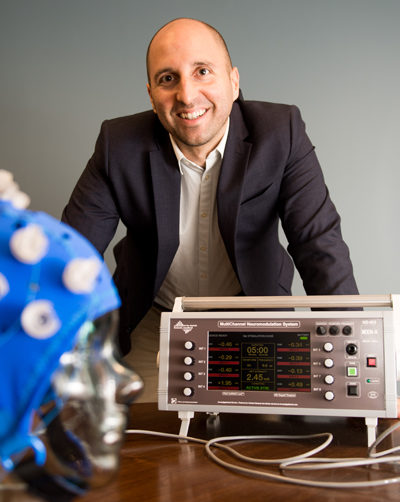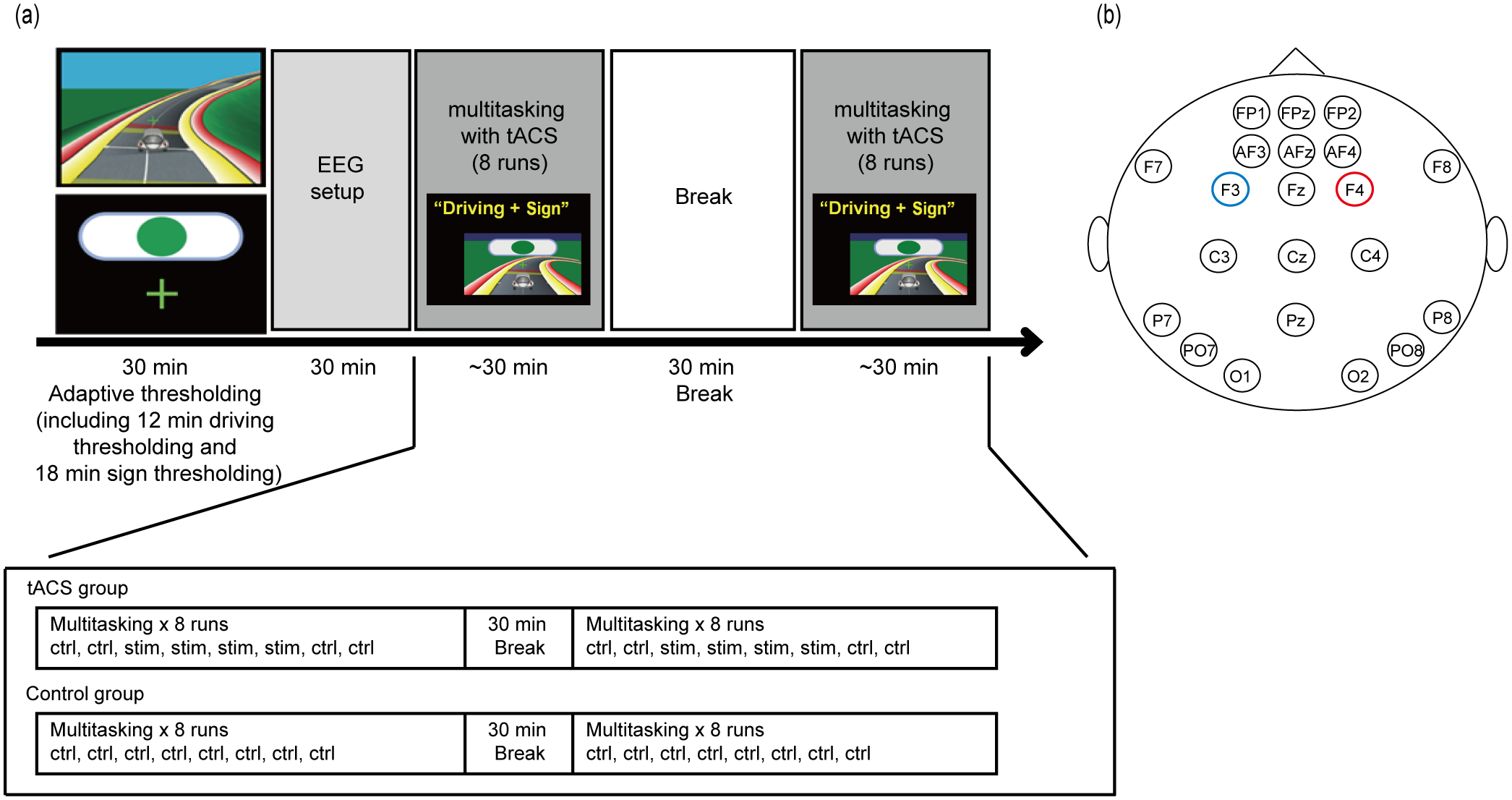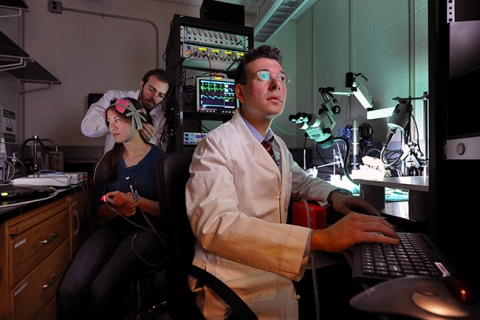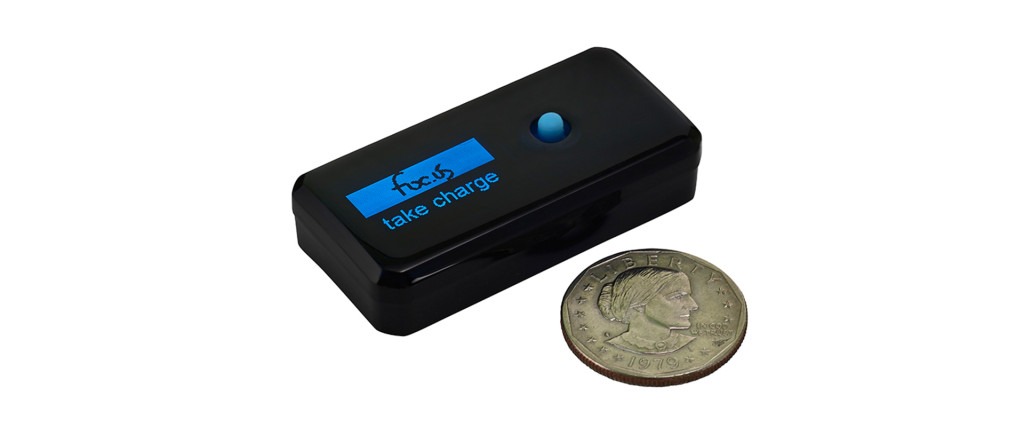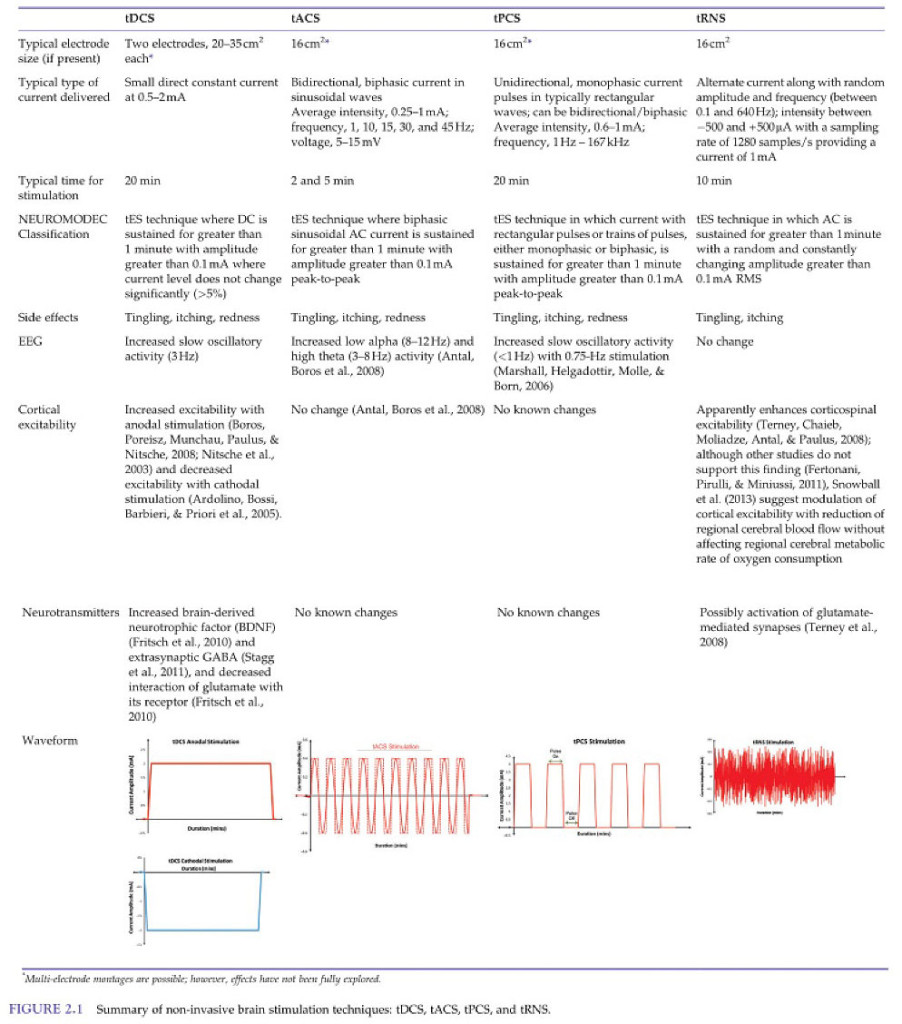Aaron J Newman of Dalhousie University and The NeuroCognitive Imaging Lab gives an introductory lecture to transcranial electrical stimulation.
In addition to tDCS he covers tACS and tRNS. It was interesting to be reminded of when and how stimulation can be detrimental to certain types of the tasks often presented in studies.
Tag Archives: tACS
The Military Discovered A Way To Boost Soldiers’ Memories, And We Tried It | Elise Hu, NPR
Have a look at the science behind DARPA research investigating the possibility of enhancing memory using tACS. Dr. Vince Walsh is the lead investigator. and team from NPR reporting.
In a multi-year study at the University of New Mexico, volunteers received a fraction of 9-volt battery’s worth of electrical stimulation to their scalps while they slept at the lab. When they woke up, they were asked to play a video game they had learned the day before. Turns out that subjects were significantly better at it after the night spent in the lab.
HD tACS to Synchronize Medial Frontal Cortex & Lateral Prefrontal Cortex Leads to Improved Executive Function
[Update 4/19] Reinhart Lab has a new paper out that is going to attract a lot of attention. Using HD-tACS, they were able to improve Working Memory in older adults (compared to younger adults). This article nicely summarizes the experiment: Brainwave Synchronization Reverses Age-related Decline in Working Memory …HD-tACS boosted interactions between theta & gamma rhythms in left temporal cortex & synchronization of theta brainwaves between left temporal cortex and prefrontal cortex. Paper: Working memory revived in older adults by synchronizing rhythmic brain circuits.
You may have noticed that I’ve not been posting as much to the blog lately. The blog is already so full of useful content for anyone looking into tDCS that I’m inclined to only post significant information that would move our current understanding of tDCS and neurostimulation forward. This article/paper describing a new technique using ‘HD tACS’ to synchronize (brainwaves) parts of the brain definitely looks intriguing and has implications for anyone paying attention to DIY neurostimulation. Very early, but very interesting.
Full story: “Turbo Charge” for Your Brain? by By Barbara Moran
“These (medial frontal cortex & lateral prefrontal cortex) are maybe the two most fundamental brain areas involved with executive function and self-control,” says Reinhart, who used a new technique called high-definition transcranial alternating current stimulation (HD-tACS) to stimulate these two regions with electrodes placed on a participant’s scalp. Using this new technology, he found that improving the synchronization of brain waves, or oscillations, between these two regions enhanced their communication with each other, allowing participants to perform better on laboratory tasks related to learning and self-control. Conversely, de-synchronizing or disrupting the timing of the brain waves in these regions impaired participants’ ability to learn and control their behavior, an effect that Reinhart could quickly fix by changing how he delivered the electrical stimulation. The work, published October 9, 2017, in the journal Proceedings of the National Academy of Sciences (PNAS), suggests that electrical stimulation can quickly—and reversibly—increase or decrease executive function in healthy people and change their behavior.
Here’s the paper (paywall): Disruption and rescue of interareal theta phase coupling and adaptive behavior. The supplemental pdf. describes the equipment used in the experiment.
High definition transcranial alternating current stimulation ( HD- tACS ). The alternating current stimulation was administered noninvasively using an MxN9-3 channel high definition transcranial electrical current stimulator from Soterix Medical (New York, NY). Eight sintered Ag/AgCl electrodes were attached to high-definition plastic holders, filled with conductive gel, and embedded in the Biosemi EEG cap. HD-tACS electrode placement was guided by current-flow modeling using HD- Explore and HD-Targets (Soterix Medical), with the goal of targeting the MFC and lPFC to facilitate the synchronization of neural activity between these regions (the in phase protocol ) or disrupt the signals being conveyed between the MFC and lPFC (the antiphase protocol ).
Listen to Bob McDonald discuss HD tACS with Prof Rob Reinhart on the always interesting Quirks and Quarks.
Adam Gazzaley – Consciousness & Neuroscience | After-On – Rob Reid
We’ve met Adam Gazzaley elsewhere on the blog, but probably because he and Rob Reid have a friendship spanning years, this is a very friendly and thorough discussion of all Adam is up to. Reid has a new book (fiction, sci-fi) called After On, and Gazzaley was called on to provide insights into a few of the book’s key concepts related to consciousness and neuroscience.
There has been a lot of talk in the literature lately about tACS as it applies to cognitive enhancement and this is explored in the conversation. If I got this right… there is a distinct pattern of ‘Midline Frontal Theta’ frequency, at around 6Hz (as measured by EEG) associated with ‘focus’ (as measured by fMRI) in the Pre Frontal Cortex. This begs the question as to whether focus could be generated by using tACS to ‘entrain’ the PFC (as in… induce 6Hz Theta in the PFC using tACS). Again I will remind the reader that I am not a scientist!
Gazzaley also brings us up to speed on the clinical trial for FDA clearance of EVO, his video game/therapeutic that Akili has developed for kids with ADHD.
The episode is embedded here, but swing over to https://after-on.com/episodes/002 to read the show notes and to learn more about Rob Reid. He has a number of fascinating interviews with other guests in his podcast and brings a lot to the table himself considering a long career both as a technologist, investor and author.
Video Games for Neuro-Cognitive Optimization
Neuroscape Lab at UCSF Publications
Enhancement of multitasking performance and neural oscillations by tACS
Nature cover story: Video gaming enhances cognitive skills that decline with age. Game Changer (pdf)
Slides From NIMH-sponsored tES Workshop Held September 29th and 30th at NIH
An email from Michelle Pearson at the NIH (because I had signed up for the online version of the workshop) alerted me today to a trove of TES (Transcranial Electric Stimulation) info being made available to us. Presenter slides (in PDF form) from the workshop were available for download. Because the download process was pretty wonky, involving many clicks and declined logins to Dropbox I thought to make them available here as well.
1-lisanby-introductory-remarks Sarah Hollingsworth Lisanby, M.D., NIH
2-rumsey-introduction Judy Rumsey, Ph.D.
3-wassermann-historical-overview Eric Wassermann, M.D., NINDS
4-parra-tdcs-mechanisms Lucas Parra, co-founder of Soterix Medial Inc. @lcparra1
5-frohlich-tacs-mechanisms @FlavioFrohlich, University of North Carolina-Chapel Hill
6-clark-combining-imaging-and-stimulation Vincent P. Clark, PhD Mind Research Network
7-woods-tes-technical-aspects Adam J. Woods, PhD @adamjwoods
8-richardson-blinding Jessica D. Richardson, Ph.D.
9-kappenman-reproducibility Emily S. Kappenman
10-bikson-computational-modeling-design Marom Bikson, CCNY @MaromBikson
11-deng-anatomical-variability-efields Zhi-De Deng, Ph.D., NIH
12-dmochowski-targeted-stimulation-sources Jacek P. Dmochowski, CCNY
13-loo-depression-trials Colleen Loo, Black Dog Institute
14-brunoni-neuropsychiatry-large-trials André R. Brunoni, @abrunoni
15-cohen-motor-learning Leonardo G. Cohen, M.D. NINDS
16-edwards-augmentation-neurorehabilitation Dylan J. Edwards PhD
17-lim-ongoing-trials Kelvin O. Lim, M.D.
18-frohlich-tacs-psychiatry-trials @FrohlichLab
19-charvet_remote-tdcs Leigh Charvet PhD, NYU
Sleep Spindles tACS and Memory Consolidation | Frohlich Lab
For the first time, UNC School of Medicine scientists report using transcranial alternating current stimulation, or tACS, to target a specific kind of brain activity during sleep and strengthen memory in healthy people.
Flavio Frohlich, PhD
Full Story: No dream: electric brain stimulation during sleep can boost memory
Paper: Feedback-Controlled Transcranial Alternating Current Stimulation Reveals a Functional Role of Sleep Spindles in Motor Memory Consolidation
A technical guide to tDCS, and related non-invasive brain stimulation tools | Clinical Neurophysiology
Many of the leading tDCS researchers contribute to this Open Access article on clinical application of transcranial electrical stimulation (tES) techniques. Read it online, or download the pdf. (HatTip to Reddit user gi67)
- 1. Introduction
- 2. Transcranial direct current stimulation
- 2.1. Selecting and preparing electrodes and contact medium
- 2.2. Selecting and preparing electrode placement
- 2.3. Selecting a stimulation protocol
- 2.4. Use of blinding and sham
- 2.5. Safety versus tolerability
- 2.6. Considerations for transcutaneous spinal DC stimulation (tsDCS)
- 2.7. Considerations for cerebellar tDCS
- 2.8. Selecting a stimulator
- 3. Transcranial alternating current stimulation (tACS)
- 4. Monitoring physiological effects of tES
- 5. Monitoring functional effects of tES
- 6. tDCS/tACS/tRNS in animal preparations
- 7. tDCS and models of electric current through the brain
- 8. tES ethics
- 9. Concluding remarks
- References
BrainKit 1.0 released
Nathan Whitmore continues to push the envelope on DIY brain stimulation. Somewhat above my limited capabilities, we can assume that as the project evolves, the build will get simpler.
BrainKit 1.0 released
To download BrainKit, click here to go to its GitHub page. You can also see an earlier post which lays out some of the concepts behind BrainKit here.Planning BrainKit started about a year ago when I was thinking about the question “now that putting together the hardware and software to make a relatively inexpensive device to stimulate the brain is basically a solved problem, what is the next major obstacle to the use of noninvasive brain stimulation?” The answer was (and still is) figuring out where in the brain to stimulate to achieve some desired effect.
BrainKit was inspired by this idea, a brain stimulator which also is capable of monitoring brain activity and using statistics to understand the neural correlates of mental states and design stimulation montages more intelligently. For instance, BrainKit can find brain regions that show different patterns of activity in fatigued and alert states—and then allow you to stimulate these regions to see if it affects alertness.
Full article: http://quicktotheratcave.tumblr.com/post/124541990103/brainkit-1-0-released
An Evening with the Consciousness Hackers | The New Yorker
For the evening’s first demonstration, Siegel helped attach electrodes to the temples of Adam Goyer, a volunteer test subject, then cued Eugene Sinkevich, an electrical engineer, to start the current. “We are at the frontier,” Siegel said, looking out at the crowd as no more than two milliamps ran through Goyer’s head. “We’ll be able to tell our kids that we used to hook up arbitrary electrical signals to our brain.”Goyer sat still for several minutes, flinching only slightly. Then it was over. How did he feel?“First, let me say I’m really nervous about putting electricity through my brain. The first wave felt like a tingling on my forehead, and I guess I’m smarter afterward, sure. Then the second wave of tACS [transcranial alternating-current stimulation, a type of stimulation in which the flow of the charge varies] I kinda felt woozy, not in a bad way, but kind of like I’m on a boat. Then the third one, I definitely had some flickering, some eye flickering: in the outside of your eyes it’s like a flash, like a strobe.”
Source: An Evening with the Consciousness Hackers – The New Yorker
Functional role of frontal alpha oscillations in creativity
Following up on the recent Flavio Frohlich paper. Some details here in the abstract about how the boost in creativity was achieved.
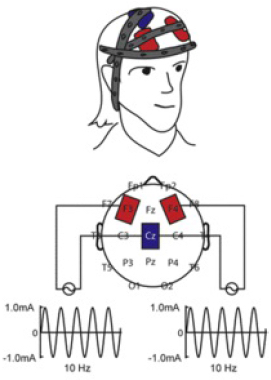
Creativity, the ability to produce innovative ideas, is a key higher-order cognitive function that is poorly understood. At the level of macroscopic cortical network dynamics, recent electroencephalography (EEG) data suggests that cortical oscillations in the alpha frequency band (8–12 Hz) are correlated with creative thinking. However, whether alpha oscillations play a functional role in creativity has remained unknown. Here we show that creativity is increased by enhancing alpha power using 10 Hz transcranial alternating current stimulation (10 Hz-tACS) of the frontal cortex. In a study of 20 healthy participants with a randomized, balanced cross-over design, we found a significant improvement of 7.4% in the Creativity Index measured by the Torrance Test of Creative Thinking (TTCT), a comprehensive and most frequently used assay of creative potential and strengths. In a second similar study with 20 subjects, 40 Hz-tACS was used instead of 10 Hz-tACS to rule out a general “electrical stimulation” effect. No significant change in the Creativity Index was found for such frontal 40 Hz stimulation. Our results suggest that alpha activity in frontal brain areas is selectively involved in creativity; this enhancement represents the first demonstration of specific neuronal dynamics that drive creativity and can be modulated by non-invasive brain stimulation. Our findings agree with the model that alpha recruitment increases with internal processing demands and is involved in inhibitory top-down control, which is an important requirement for creative ideation.
There’s a paywall to the full paper, but Kurzweil.net has the details.
Alpha-rhythm brain stimulation shown to boost creativity
Scientists Use Brain Stimulation to Boost Creativity
Sounds like some kind of tACS. Will try to follow-up with more info.
See Also: Your Brain on Electricity
For the Cortex study, Frohlich’s team enrolled 20 healthy adults. Researchers placed electrodes on each side of each participant’s frontal scalp and a third electrode toward the back of the scalp. This way, the 10-Hertz alpha oscillation stimulation for each side of the cortex would be in unison. This is a key difference in Frohlich’s method as compared to other brain stimulation techniques.
Each participant underwent two sessions. During one session, researchers used a 10-Hertz sham stimulation for just five minutes. Participants felt a little tingle at the start of the five minutes. For the next 25 minutes, each participant continued to take the Torrance Test of Creative Thinking, a comprehensive and commonly used test of creativity. In one task, each participant was shown a small fraction of an illustration – sometimes just a bent line on a piece of paper. Participants used the line to complete an illustration, and they wrote a title when they finished.
In the other session each participant underwent the same protocol, except they were stimulated at 10 Hertz for the entire 30 minutes while doing the Torrance test. The tingling sensation only occurred at the start of the stimulation, ensuring that each participant did not know which session was the control session.
Because rating creativity or scoring a test can involve subjectivity, Frohlich sent each participant’s work to the company that created the test. “We didn’t even tell the company what we were doing,” Frohlich said. “We just asked them to score the tests.
”Then Frohlich’s team compared each participant’s creativity score for each session. He found that during the 30-minute stimulation sessions, participants scored an average 7.4 percentage points higher than they did during the control sessions.
via Scientists Use Brain Stimulation to Boost Creativity.
link to paper: (paywall) http://www.sciencedirect.com/science/article/pii/S0010945215001033
FOC.US — tACS, tRNS, tPCS, Sham, Double Blind and Voltage Control
[Update 3/17/15 Foc.us just announced version 1.0 of their new Mac software:
foc.us+ OS X software is now available
http://update.foc.us/softwares/foc.us-dock-sw-mac-1.0.stable.dmg ]
I’ve copied the entire post from the Foc.us blog. This is a significant development. tACS, transcanial alternating current stimulation, has been discussed in the DIY community as a hopeful, eventual, capability that would evolve out of a microprocessor-based DIY project. That means software and a level of complexity that most DIYers aren’t prepared to take on. But not only tACS, tRNS – transcranial random noise stimulation, tPCS – transcranial pulsed current stimulation (something I know nothing about), and a Sham setting… well, Foc.us has definitely set the bar here. This is a $199 device! (Plus headset, sponges and shipping $298) [CORRECTED]. Windows-only software at present though Mac ‘coming soon’). This will have a serious impact on any of the DIY commercial tDCS devices.
That said, this is an announcement from the manufacturer. I expect the Reddit tDCS crowd will be exploring these claims over the next few months. This is exciting news and opens the door to some serious citizen science.
tACS, tRNS, tPCS, Sham, Double Blind and Voltage Control – a look at the new features in foc.us firmware update 1.7
The latest firmware update for the foc.us v2 developer edition is now available for download. It’s quite a big release in terms of new features so here’s a quick run down of whats new.
New modes – tACS, tRNS, tPCS
In addition to tDCS (constant current) you can now create different energy waveforms – shaped like waves, pulses or noise.
tACS – transcranial alternating current stimulation
tACS mode allows you to create a sine wave current where you can set the maximum current, current offset and frequency. It is even possible for the polarity of the electrodes to switch – flipping a cathode to an anode (and vice versa) up to 300 times per second.
Full explanation of tACS settings can be found here.
tPCS – transcranial pulsed current stimulation
tPCS mode enables you to create pulses of current. You can control the frequency, offset and also the duty cycle of the waveform. Full explanation of tPCS settings can be found here.
tRNS – trancranial random noise stimulation
tRNS mode can create random waveforms where either the frequency, the current or both take random values between the min and max values set. tRNS settings are here.
Sham – Off, On or Double Blind
Sham mode is used by researchers to check for placebo effect in studies. If you set to On, the current will begin, but then turn off (after a user configurable duration). But if you want to test yourself, knowing sham was on would defeat the purpose. But if you set sham to “double blind” then you may or may not receive a sham session.
Voltage Control
During a neuromodulation session the resistances involved vary and so the voltage changes to maintain the target current. It is now possible to set a limit on the voltage you want to use in all modes. If you find you are sensitive to the voltage you can use this setting to find a comfortable setup.
Wave, Pulse and Noise programs
These are pretty advanced settings so there are also three new programs with default values you can try.
Summary
These new settings give you even greater control over your neuro-stimulation options. And with double blind you check if its working for you.
foc.us – take charge™
via FOC.US — tACS, tRNS, tPCS, Sham, Double Blind and Voltage….
tDCS tACS tPCS tRNS Comparison Chart
Borrowed (screen shot) from the July 2014 Roi Cohen Kadosh edited ‘The Stimulated Brain’ (Google Books link which, though many pages missing, is still full of excellent info or buy it on Amazon,affiliate link).
Click image to open in full size.
How the brain ignores distractions | News from Brown
As our awareness of brainwave activity mapped to behavior evolves, we’re sure to see the development of tACS for treatment and enhancement. I am betting that Neurolectrics, with their lab-level NIB/EEG device, Starstim, have been collecting valuable data in this area.
Jones and Kerr are now working with Dr. Ben Greenberg, professor of psychiatry and human behavior, to test whether they can use noninvasive, transcranial alternating current electrical stimulation (tACS) to take advantage of this process. They will test whether they can use the technology to manipulate alpha and beta waves between parts of the brain such as the somatosensory cortex and the rIFC to suppress attention to, or even the detection of, pain.
In a similar vein, research results show that mindfulness meditation, also possibly via the mechanism of throttling attention via control of alpha rhythms, can help people ignore depressive thoughts. Jones and Kerr are also interested to study whether explicit manipulation of alpha and beta waves between a different part of the cortex and the rIFC could provide much the same relief.
The Brown Institute for Brain Science recently outfitted a new lab on campus with the needed hardware for tACS and other brain stimulation research. BIBS and the Norman Prince Neurosciences Institute are funding the collaboration with Greenberg.
The effects of theta transcranial alternating current stimulation – PubMed
Especially in light of the recent Aldis Sipolins study which found no transfer (improvement to fluid intelligence) with his tDCS/exercise protocol, I think it’s smart to keep our eye on tACS. Although far less researched, I’ve noticed consistent reports of positive effects. Google the article title and you can find a few links to full pdfs.
The results showed that active theta tACS affected spectral power in theta and alpha frequency bands. In addition, active theta tACS improved performance on tests of fluid intelligence. This influence was more pronounced in the group of participants that received stimulation to the left parietal area than in the group of participants that received stimulation to the left frontal area. Left parietal tACS increased performance on the difficult test items of both tests (RAPM and PF&C) whereas left frontal tACS increased performance only on the easy test items of one test (RAPM). The observed behavioral tACS influences were also accompanied by changes in neuroelectric activity. The behavioral and neuroelectric data tentatively support the P-FIT neurobiological model of intelligence.
via The effects of theta transcranial alternating current stimulation (… – PubMed – NCBI.

